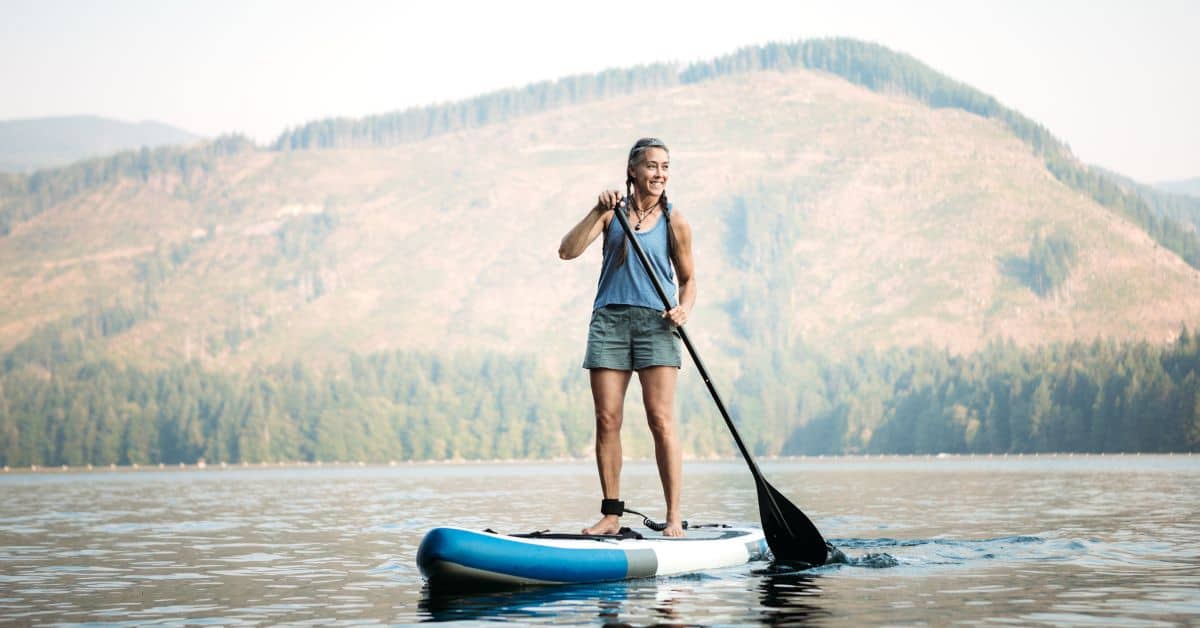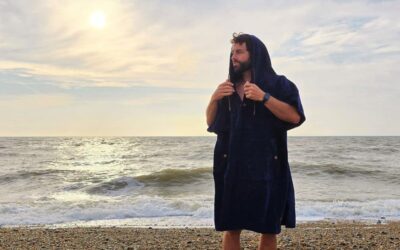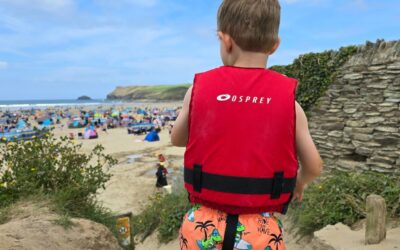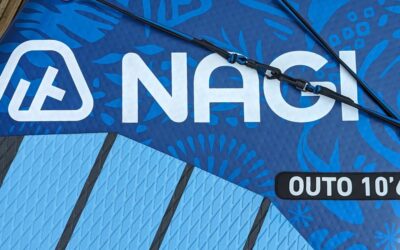Stand up paddleboarding or SUP for short has gained immense popularity in recent years and is one of the fastest-growing watersports in the world.
This is no surprise considering how great paddleboarding is for fitness and fun, but there are some challenges to learn. If you’ve never tried SUPing before, here’s everything we’ll cover in this article to help get you started:
Essential Paddleboarding Gear and Clothing – Grab a paddle board and get ready to hit the water with these must-have essentials.
Paddleboarding Techniques – Learn the basics so that you spend more time on your SUP and less time in the water.
SUP Tips and Tricks – A few helpful paddle boarding tips to help you get the most out of paddle boarding.
Whether you’re looking to explore calm scenic lakes, ride ocean waves, or simply enjoy a peaceful workout on the water, paddleboarding offers a versatile and accessible experience for people of all ages and fitness levels, some dogs even enjoy paddleboarding too!
Now let’s dive in!
What is Paddleboarding?
Paddleboarding, also known as stand-up paddleboarding or SUP, originated in Hawaii and has evolved into a popular water sport worldwide.
It involves standing on a long, wide board, similar to a surfboard, and using a single-bladed paddle to propel yourself forward.
Paddleboarding offers a fantastic full-body workout while providing an opportunity to connect with nature and enjoy the tranquillity of the water.
Disclaimer: If you make a purchase via the links on our site, I may earn an affiliate commission at no additional cost to you. You can read my affiliate disclosure in the privacy policy. Thanks for your support!
Getting Started with Paddleboarding
If you’re ready to give paddleboarding a try, here are some essential items you’ll need to get started:

Stand Up Paddle Board
To begin, you will first need a paddle board. If you are brand new to the sport, I would recommend renting a SUP or borrowing from a friend for your first paddle board outing. This allows you to get a feel for the sport before committing to purchasing your own gear.
However, once you discover your love for SUP and desire to get on the water more frequently, owning your own stand up paddle board becomes a wise investment.
When choosing a SUP board for the first time there are several factors you should consider which are, your weight, skill level, and intended use. Different boards excel in various disciplines, such as recreational paddling, surfing, touring, racing, and SUP yoga.
To delve deeper into the paddle boards best suited for beginners, view The Best Budget Paddle Boards here.
SUP Paddle
A SUP paddle is an essential component of stand-up paddle boarding, playing a critical role in manoeuvring and propelling the board through the water. SUP paddles are uniquely designed with a stretched-out canoe paddle shape and a tear-drop-shaped blade that angles forward for maximum efficiency.
Constructed from lightweight and durable materials such as carbon fibre or fibreglass, SUP paddles are available in various lengths and designs to accommodate different paddler preferences and styles.
Adjustable SUP paddles allow for personalized customization, and to set the paddle length for stand-up paddle boarding, simply stand the paddle upright in front of you and choose a length that extends up to your wrist when you raise your arm above your head.
Choosing the right paddle size and construction ensures a comfortable grip, efficient strokes, and an enjoyable paddling experience.

Pump
If you are using an inflatable paddle board you will need a SUP pump to inflate your paddle board. Most iSUPs packages include a manual pump designed for inflating paddle boards, however, while these pumps are functional, investing in an electric SUP pump can save you time and energy.
Electric pumps automatically inflate the board with the push of a button, eliminating the need for manual effort. They are convenient, efficient, and ideal for frequent paddlers or those looking to streamline their setup process. To learn more about electric SUP pumps, see The Best Electric Pumps for Paddle Boards.
Leash
A paddle board leash is a must-have safety accessory for stand-up paddle boarding. It is a coiled or straight cord that attaches to your ankle on one end and to the board on the other. The leash prevents the board from getting away from you in case you fall off, ensuring that it stays within reach at all times. This not only helps prevent accidents but also makes it easier to retrieve your board and reduces the risk of it becoming a hazard to other water users.
Sun Protection
If you find yourself paddleboarding on a sunny day it’s important to wear waterproof sun cream, sunglasses, and sun-protective clothing to shield yourself from harmful UV rays while enjoying your time on the water.
Paddle Board Clothing
When the time comes to head out on your SUP, knowing what to wear paddle boarding is crucial for your comfort, protection, and overall enjoyment on the water.
If going for a paddle during the warmer months of the year, most opt for general swimwear such as a bikini or board shorts paired with a rash guard for added protection from the sun’s rays. If you are the kind of person who enjoys the benefits cold water has to offer and decides to paddle board in colder conditions where hypothermia is a potential risk, wearing a wetsuit or dry suit provides the necessary insulation and protection.
Once out of the water, a changing robe is an optional extra but in my opinion is a must-have accessory for paddleboarding as it provides privacy, warmth, and convenience when changing in and out of wet gear.
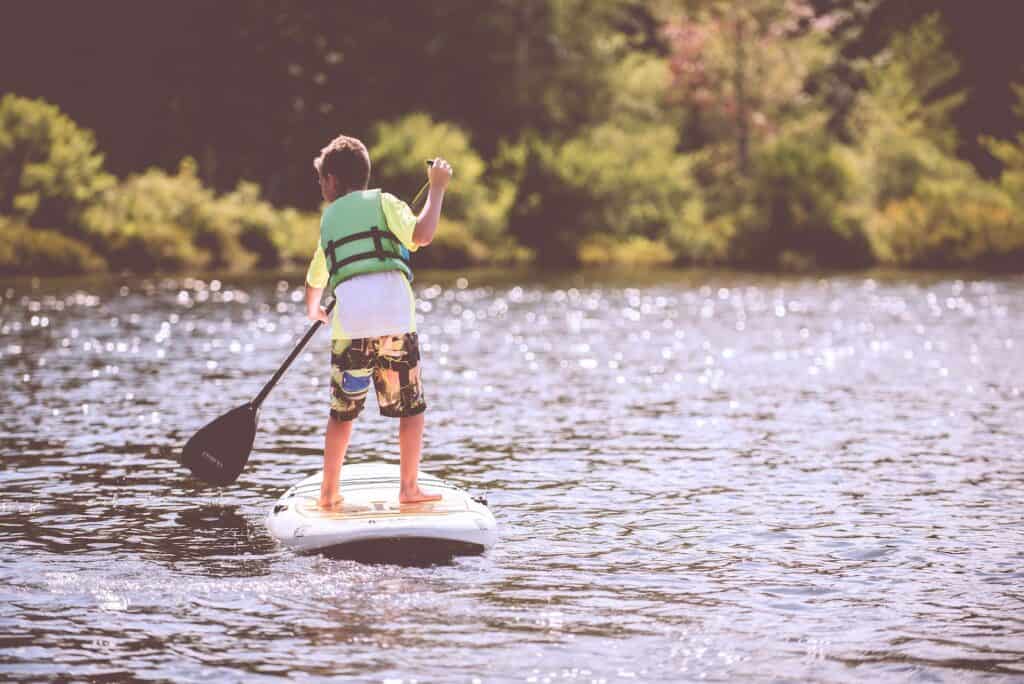
Personal Floatation Device
A Personal Flotation Device (PFD) is an essential safety item for any water activity, including paddle boarding. Also known as a life jacket, a PFD is designed to keep you afloat in the water, providing buoyancy and ensuring your safety. A well-fitted and properly worn PFD will offer peace of mind, allowing you to fully enjoy your paddle boarding adventure while knowing you have a reliable safety device at hand.
Additional Items
In addition to a PFD, carrying a safety whistle is a good idea. If you are planning a late paddle with the potential of being out after sunset, be sure to have a light on board. I would recommend a head torch or a mountable SUP lamp.
Paddleboarding Techniques
As a beginner, you will first need to learn a few simple techniques before you start gliding across the water on your paddle board.
To get started here are some basic techniques to learn:
How to Stand Up on Your SUP

Once you have your paddleboard in the water, the first step is to learn how to stand up with confidence. These simple steps will help ensure a smooth transition from kneeling to standing.
Begin by kneeling in the middle of the board, keeping your hands on either side for stability.
Gradually shift your weight forward, bringing one foot up onto the board, followed by the other foot. Keep your feet shoulder-width apart for a stable base.
As you start to rise, maintain a slight bend in your knees to help maintain balance and absorb any movements.
How to Balance
Now stood upright on your SUP, next you must master the art of balance. Follow these few simple tips to improve your stability on your stand up paddle board.
Stand with your feet shoulder-width apart and your knees slightly bent to maintain stability.
Keep your gaze focused on the horizon rather than looking down at your feet.
With both feet firmly planted on the board, engage your core muscles to help you stay balanced and distribute your weight evenly.
Allow your body to find its natural centre of balance, making any necessary adjustments by shifting your weight or making subtle movements with your feet.
How to Fall and Get Back on Your SUP
Falling off your stand-up paddleboard is a normal part of the learning process, but knowing how to recover and get back on the board efficiently is essential.
What to do when you inevitably fall off…
As you lose your balance and feel yourself falling, try to fall away from the board to avoid any potential collisions or injuries.
Once in the water, locate your board and retrieve your paddle, ensuring they are within reach.
How to climb back onto your paddle board
Position yourself at the side of the board, holding onto the side handle to stabilize yourself.
Keeping a firm grip on the handle, kick your legs and use your upper body strength to propel yourself onto the board.
Try to distribute your weight evenly to maintain stability as you climb back on.
Once back on the board, find your centre of balance and regain your composure before resuming your paddleboarding adventure.
Remember, falling is part of the process, and it’s important to approach it with a positive mindset. By practising the art of falling and getting back on your SUP, you’ll build confidence and improve your skills over time.
How to Hold a SUP Paddle
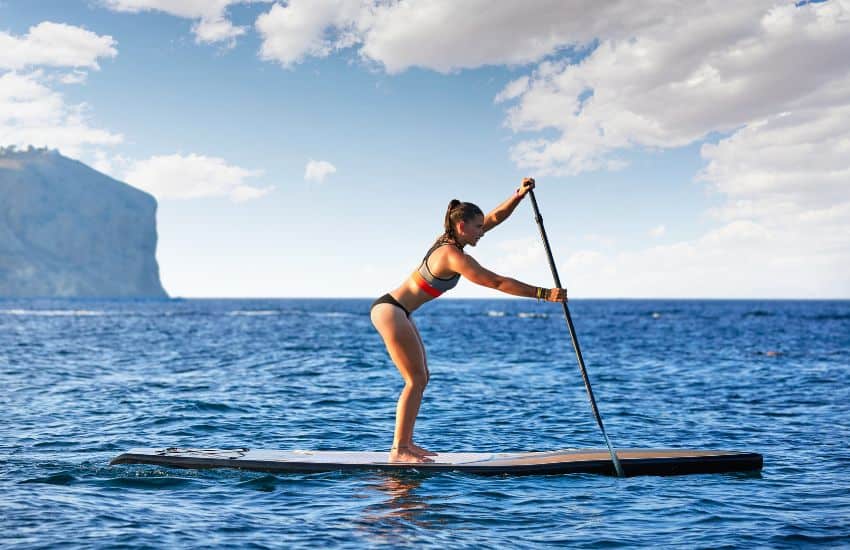
An incorrect grip of the paddle is a fairly common sight to see of first-time paddle boarders. To avoid making the same simple mistake, follow these easy steps to ensure a proper grip on your paddle.
Start by standing upright with the paddle in front of you, blade facing towards the front of your paddle board.
Place one hand on the handle of the paddle, ensuring that your hand is positioned at the top of the T-grip.
Position your other hand around the shaft of the paddle keeping your hands slightly wider than shoulder-width apart.
Remember to alternate your paddle strokes on each side of the board to maintain a steady and balanced paddling rhythm.
Basic Strokes
As a beginner, there are only a few simple strokes to master to get you gliding smoothly on your stand up paddle board.
Forward Stroke
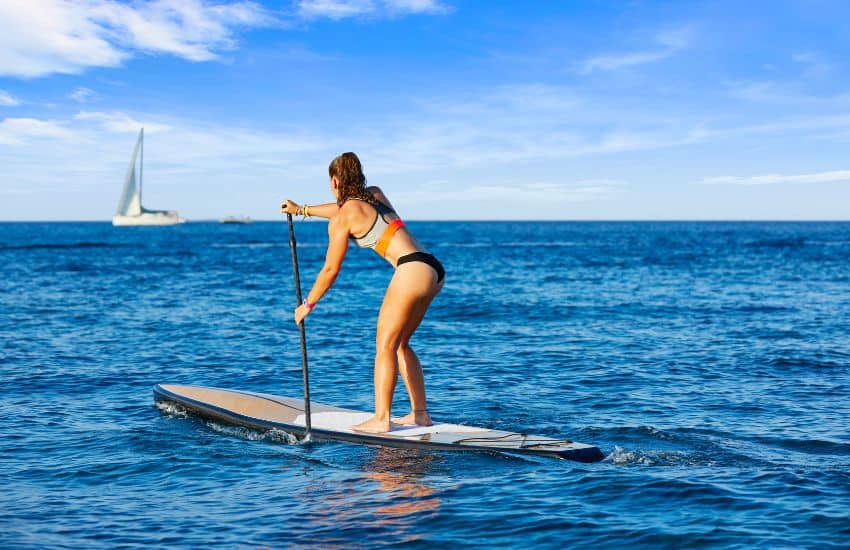
The forward stroke is the most basic and is used to propel yourself forward.
1. Begin by reaching approximately 60 cm forward with your paddle, planting it in the water then push the paddle blade beneath the water’s surface until it is fully submerged.
2. With your arms straight, engage your core and rotate your torso as you move the paddle back towards your feet. Remember to push down on the paddle grip with your top hand instead of relying on your lower arm for pulling power.
3. Lift the paddle out of the water and repeat the stroke on the opposite side of the board. To glide forward in a straight line, alternate strokes between both sides of the board, aiming for around three or four strokes per side before switching.
Reverse Stroke
The reverse stroke is used for slowing down, stopping, and turning.
1. When paddling on the left side, reach back and place the paddle in the water near the tail of your board, ensuring the blade is fully submerged.
2. Maintain straight arms and engage your torso rotation, avoiding excessive reliance on arm strength to pull the blade forward.
3. Executing the reverse stroke on the left side will cause the board’s nose to turn left, and vice versa.
Sweep Stroke
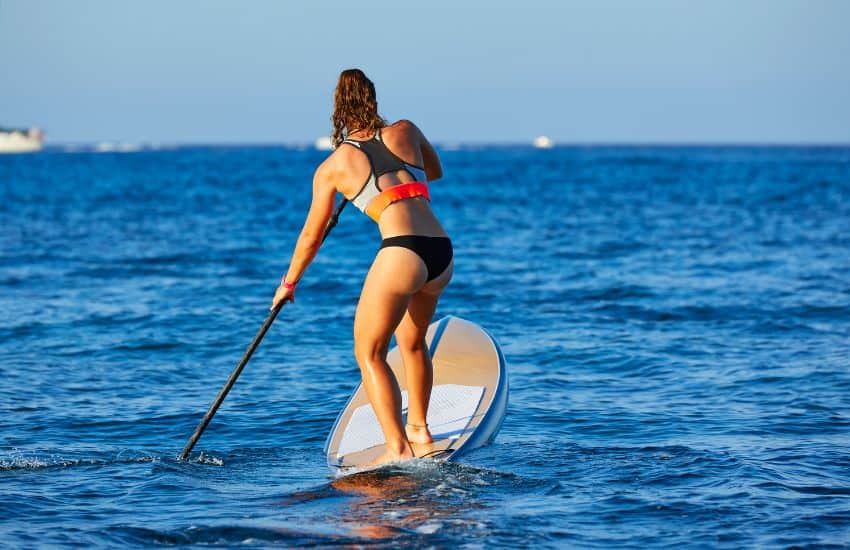
The sweep stroke is used for turning and manoeuvring.
1. Position the paddle blade near the front of the board and angle it away from the board.
2. Initiate a sweeping motion, smoothly moving the paddle blade away from the board in a wide arc.
3. Apply pressure against the water as you sweep, using your core and upper body to control the turning and manoeuvring of the paddleboard.
Mastering these basic strokes will provide you with the fundamental techniques needed to navigate, control your speed, and turn your stand-up paddleboard confidently.
Paddle Boarding Tips for Beginners

If you’re new to paddle boarding, here are some stand up paddle boarding tips to help you get started and improve your skills:
For your first outing, whilst learning how to paddle board. Choose a location that is calm with flat water on a day with minimal wind to build confidence and get comfortable on the board. As you gain experience, you can gradually explore more challenging conditions.
Find a spot where you can wade into the water to launch your SUP. Practice standing on your board and staying balanced before paddling away from land.
Practice the art of falling and getting back on your paddle board to build confidence. Remember falling is inevitable and part of the learning process.
Keep your first paddle boarding sessions short, ideally less than 60 minutes.
- If you plan to paddleboard in the UK, it is essential to check whether a waterways licence is required to ensure compliance with regulations and avoid any legal issues.
Paddleboarding is most enjoyable when done with friends, help encourage and support each other as you learn a new skill but most importantly have fun together on the water.
Recommended Reading: 19 Things I Wish I Knew When I Started Stand Up Paddle Board
Paddleboarding Safety Tips
While paddleboarding is a safe and enjoyable activity, it’s always a good idea to prioritise safety.
Here are some key safety tips to keep in mind:
Check Weather Conditions
Before heading out, check the weather forecast and water conditions. Avoid paddleboarding during storms, strong winds, or rough waters. Be aware of any changes in weather that may occur while you’re on the water and be prepared to return to shore if conditions worsen.
Wear a Personal Flotation Device (PFD)
Always wear a properly fitting personal flotation device (PFD) when paddleboarding. A PFD is a crucial safety measure that can save your life in the event of an emergency. Choose a PFD designed specifically for paddleboarding or water sports, and ensure it is in good condition and properly fastened.
Related Article: 9 Best Life Jackets for Paddle Boarding (SUP) in 2023
Be Aware of Your Surroundings
Pay attention to your surroundings and be aware of other watercraft, swimmers, and potential hazards. Stay clear of areas with strong currents, underwater obstacles, or dense boat traffic. Maintain a safe distance from other paddlers and respect the rights of others using the waterway.
Sun Protection
Protect yourself from the sun’s harmful rays while paddleboarding. Apply sunscreen with a high SPF to exposed skin, including your face, arms, and legs. Wear a hat and sunglasses to shield your eyes and face from direct sunlight. Consider wearing a rash guard or lightweight clothing for additional sun protection.
Hydration and Nutrition
Stay hydrated before, during, and after your paddleboarding session. Bring a water bottle with you and take regular sips to prevent dehydration. It’s also important to fuel your body with nutritious snacks or meals before engaging in a paddleboarding session to maintain energy levels.
Buddy System
Whenever possible, paddleboard with a buddy or in a group. Having others with you provides an extra layer of safety and support. If an emergency situation arises, you can rely on each other for assistance. Additionally, paddleboarding with others enhances the overall experience and makes it more enjoyable.
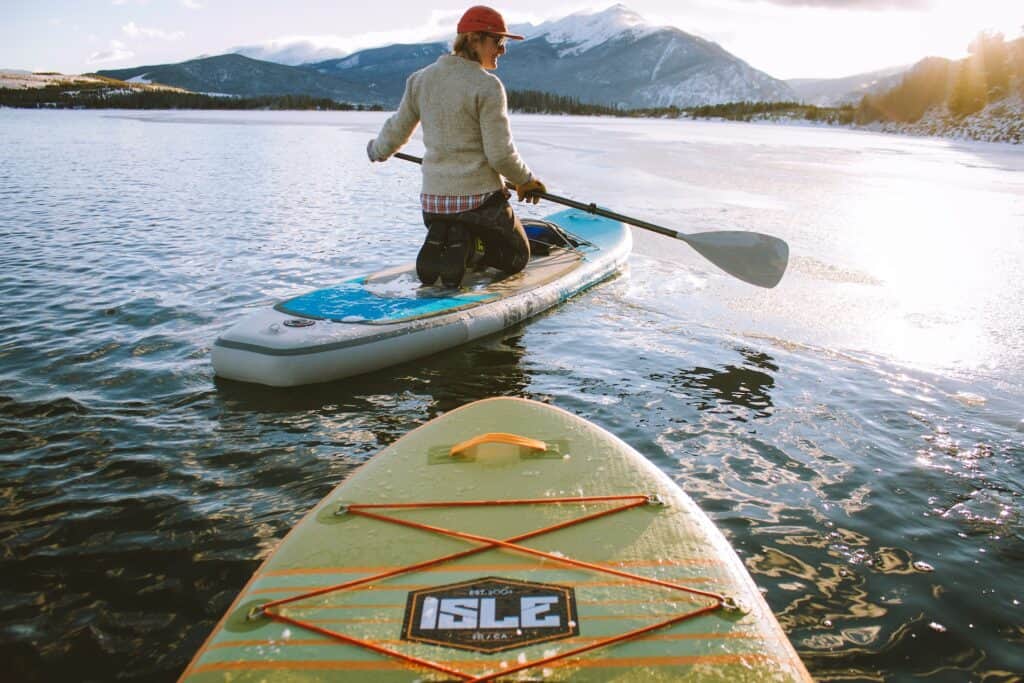
Final Thoughts
Paddleboarding is a versatile and immensely rewarding activity that seamlessly combines adventure, physical fitness, relaxation, and a profound connection with the natural world found within our often overlooked blue spaces.
As you embark on your paddleboarding journey, remember that practice makes perfect, so embrace the learning process and practice proper paddle boarding techniques, gradually challenging yourself to improve your skills.
So, grab your paddleboard, head out to the water, and happy paddleboarding!
How To Paddle Board FAQ
Do I need any prior experience to try paddleboarding?
No, paddleboarding is suitable for beginners. However, it’s recommended to take a lesson or join a group session to learn proper paddling techniques and safety guidelines.
What type of clothing should I wear while paddleboarding?
Wear comfortable and lightweight clothing suitable for the weather. Consider wearing a rash guard or moisture-wicking fabric to stay comfortable and protect your skin from the sun.
Can I paddleboard if I don’t know how to swim?
While it’s not required to be an expert swimmer, it’s recommended to have basic swimming skills and wear a PFD for safety.
How long does it take to learn paddleboarding?
The learning curve for paddleboarding varies from person to person. Most people can become comfortable on a paddleboard with consistent practice and proper instruction within a few sessions.
Can I paddleboard alone?
It’s generally recommended to paddleboard with a buddy or in a group for safety purposes. However, if you choose to paddleboard alone, ensure that you inform someone about your plans and always follow safety guidelines.
Is it easy to paddle board?
Paddleboarding is generally considered an accessible and beginner-friendly activity. While there may be a learning curve for beginners, with practice and guidance, most people quickly find their balance and gain confidence on the water. Factors such as water conditions, fitness level, and the type of paddleboarding activity can influence the level of ease. With a positive mindset and a willingness to learn, paddleboarding can be an enjoyable experience for all.

About the Author
Steve Cleverdon is an adventure blogger dedicated to helping outdoor enthusiasts make the most of their outdoor experiences. With years of travel and many epic adventures including a 3000-kilometre solo hike across New Zealand, Steve has amassed practical knowledge on outdoor gear. You can learn more about his adventures here. Through expert reviews, recommendations, and guides, he equips his readers with the best gear for their next adventure. If you want to send Steve a quick message, visit his contact page here.

